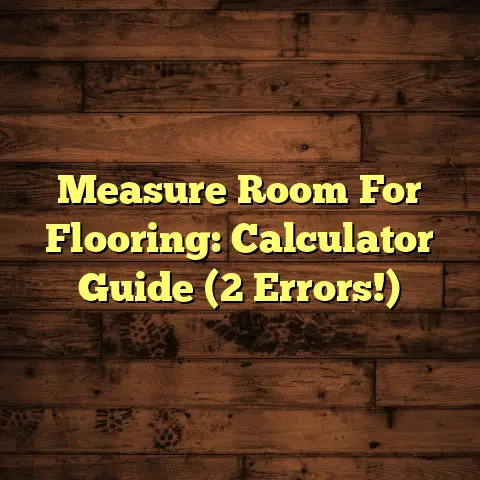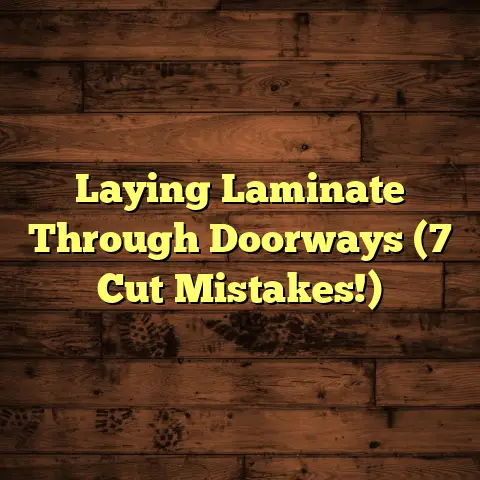Laminate Over Hardwood? (3 Top Reasons!)
Ah, autumn! The season of pumpkin spice, cozy sweaters, and… home renovations? As the leaves change color, so does our desire to refresh our living spaces. There’s something about the crisp air that makes us want to nest and create a warm, inviting atmosphere.
Or maybe you’re reading this in spring, with the urge to throw open the windows and lighten things up after a long winter. Either way, seasonal shifts often spark the renovation bug!
One of the biggest changes you can make is to your flooring. And that’s where the question arises: should you rip out that old hardwood? Or is there a better option?
Enter laminate flooring. It’s become increasingly popular, and for good reason. Trends in flooring are constantly evolving, and laminate offers a fantastic blend of affordability, style, and ease.
But can you put laminate over hardwood? And should you? Let’s dive in and see why laminate flooring might just be the perfect solution for your seasonal renovation project.
Section 1: Understanding Laminate Flooring
So, what exactly is laminate flooring? Let’s break it down.
Laminate is a multi-layer synthetic flooring product fused together through a lamination process. Think of it like a super-durable, high-tech sandwich for your floor!
At its core, you’ll usually find a high-density fiberboard (HDF) or medium-density fiberboard (MDF) core. This gives the laminate its stability and strength.
Then comes the magic: the photographic layer. This is a high-resolution image that replicates the look of natural wood, stone, or even tile. It’s this layer that gives laminate its amazing versatility.
Finally, a clear protective layer sits on top. This wear layer is what makes laminate so resistant to scratches, stains, and fading. It’s what allows it to stand up to the rigors of daily life.
The technology behind laminate has come a long way. Years ago, laminate was easily recognizable as “fake” wood. Not anymore!
Modern laminate flooring offers incredibly realistic textures and patterns. Some even have embossed surfaces that mimic the grain of real wood.
The variety of styles, colors, and textures available is truly impressive. Want the look of reclaimed barn wood? There’s a laminate for that.
Dreaming of elegant oak flooring? You guessed it – there’s a laminate for that too.
You can even find laminates that mimic the look of slate, travertine, or even polished concrete!
Here are a few popular styles I’ve seen homeowners gravitate towards:
-
Hand-scraped laminate: This style offers a rustic, textured look that mimics the appearance of hand-scraped hardwood.
-
Embossed-in-register (EIR) laminate: This type of laminate aligns the texture with the photographic layer, creating an incredibly realistic wood-grain feel.
-
Wide-plank laminate: Wide planks are a popular trend in flooring, and laminate offers this look at a fraction of the cost of wide-plank hardwood.
-
Waterproof laminate: Ideal for kitchens, bathrooms, and basements, waterproof laminate is designed to resist moisture and prevent water damage.
-
Laminate tiles: These mimic the look of ceramic or stone tiles, offering a durable and easy-to-maintain alternative.
Laminate flooring offers an attractive way to refresh your space without breaking the bank. But is it really a good idea to install it over existing hardwood? Let’s explore the reasons why it might be.
Section 2: Reason 1 – Cost-Effectiveness
Let’s face it: renovations can be expensive. One of the biggest advantages of laminate flooring is its cost-effectiveness.
Compared to hardwood, laminate is significantly more affordable, both in terms of materials and installation.
Let’s look at some numbers. On average, hardwood flooring can cost anywhere from $8 to $25 per square foot installed.
Laminate, on the other hand, typically ranges from $3 to $12 per square foot installed. (Source: HomeAdvisor). That’s a considerable difference!
Consider a 200-square-foot room. Hardwood could set you back anywhere from $1,600 to $5,000. Laminate? More like $600 to $2,400.
That’s a potential savings of hundreds, if not thousands, of dollars. And that’s just for one room!
But the cost savings don’t stop there. Laminate also offers long-term financial benefits.
It’s incredibly durable and resistant to scratches, stains, and fading. This means you won’t have to refinish it like you would with hardwood.
Refinishing hardwood can cost several dollars per square foot, and it’s a messy, time-consuming process.
Laminate requires minimal maintenance. Regular sweeping and occasional mopping are usually all it takes to keep it looking its best.
Here’s a quick breakdown of the cost comparison:
| Feature | Hardwood Flooring | Laminate Flooring |
|---|---|---|
| Material Cost | $5 – $15/sq ft | $1 – $5/sq ft |
| Installation Cost | $3 – $10/sq ft | $2 – $7/sq ft |
| Refinishing | Required every | Not Required |
| 7-10 years | ||
| Maintenance | More Demanding | Less Demanding |
Now, let’s talk about scenarios where laminate really shines.
Are you on a tight budget? Laminate can help you achieve the look you want without breaking the bank.
Are you looking for a temporary flooring solution? Maybe you’re planning to renovate again in a few years. Laminate is a great option that won’t break the bank.
Do you have pets or kids? Laminate’s durability makes it an ideal choice for high-traffic areas and homes with active families.
I’ve seen homeowners use laminate to transform basements, playrooms, and even rental properties. It’s a versatile and cost-effective solution that can add value to any space.
One thing I always tell my clients is to consider the lifespan they expect from their flooring. Hardwood, with proper care, can last for generations.
Laminate, while durable, typically has a lifespan of 10-20 years. If you’re looking for a long-term investment, hardwood might be the better choice.
However, if you’re on a budget or looking for a stylish and durable option that won’t break the bank, laminate is definitely worth considering.
Section 3: Reason 2 – Easy Installation and Maintenance
Okay, so laminate is cost-effective. But what about installation? Is it a nightmare to install compared to hardwood?
The answer is a resounding no! In fact, laminate flooring is known for its easy installation process.
One of the biggest advantages of laminate is its “click-lock” or “snap-together” system. This means that the planks simply lock together, without the need for nails, glue, or staples.
Think of it like putting together a giant puzzle! It’s a DIY-friendly project that can save you a lot of money on professional installation costs.
Now, let’s talk about installing laminate over existing hardwood. This is where things get really interesting.
In many cases, you can install laminate directly over existing hardwood without the need for extensive demolition or preparation.
This saves you time, money, and a whole lot of mess! Imagine the dust and debris you’d avoid by not having to rip up your old hardwood floor.
However, there are a few things to consider before installing laminate over hardwood:
-
Subfloor Condition: Make sure your existing hardwood floor is level, clean, and dry. Any unevenness or moisture issues need to be addressed before installing laminate.
-
Underlayment: It’s always a good idea to install an underlayment between the hardwood and the laminate. This provides cushioning, reduces noise, and helps protect against moisture.
-
Door Clearances: Keep in mind that adding laminate on top of hardwood will raise the floor height slightly. Make sure your doors can still swing freely.
Here are some tips for DIY installation:
-
Measure Carefully: Accurate measurements are essential for a successful installation.
-
Use the Right Tools: You’ll need a saw, measuring tape, tapping block, and spacers.
-
Follow the Manufacturer’s Instructions: Each laminate product is slightly different, so be sure to read and follow the manufacturer’s instructions carefully.
-
Take Your Time: Don’t rush the process. Take breaks when you need them, and double-check your work as you go.
Now, is DIY installation right for everyone? Not necessarily. If you’re not comfortable with DIY projects, or if you have a large or complex space, hiring a professional installer is always a good idea.
A professional can ensure that the laminate is installed correctly and efficiently. They can also handle any unexpected issues that may arise.
But even if you hire a professional, you’ll still save money compared to installing hardwood. The installation process for laminate is simply faster and easier.
Once your laminate floor is installed, you’ll be amazed at how easy it is to maintain.
Unlike hardwood, laminate doesn’t require refinishing. You won’t have to worry about sanding, staining, or applying polyurethane.
Cleaning laminate is a breeze. Simply sweep or vacuum regularly to remove dirt and debris. For tougher stains, you can use a damp mop and a mild cleaning solution.
Laminate is also resistant to scratches and stains. This makes it a great choice for homes with pets or kids. You won’t have to worry about constantly cleaning up spills or worrying about scratches.
Here’s a quick comparison of maintenance requirements:
| Feature | Hardwood Flooring | Laminate Flooring |
|---|---|---|
| Cleaning | Special Cleaners | Mild Soap & Water |
| Refinishing | Required | Not Required |
| Scratch Resistance | Low | High |
| Stain Resistance | Low | High |
I’ve had clients tell me that laminate has been a lifesaver in their busy households. They love the fact that they can spend less time cleaning and more time enjoying their homes.
So, if you’re looking for a flooring option that’s easy to install and maintain, laminate is definitely worth considering.
Section 4: Reason 3 – Versatility and Style Choices
We’ve talked about cost and ease of installation. But what about style? Can laminate really compete with the beauty and elegance of hardwood?
Absolutely! As I mentioned earlier, the technology behind laminate has come a long way.
Today’s laminate flooring offers an incredible range of styles, colors, and patterns. You can find laminate that mimics the look of virtually any type of wood, stone, or tile.
Whether you prefer a contemporary, rustic, or traditional style, there’s a laminate that will fit your design aesthetic.
Let’s explore some of the options:
-
Wood-Look Laminate: This is the most popular type of laminate. You can find it in a variety of wood species, colors, and plank sizes. From classic oak to exotic acacia, the possibilities are endless.
-
Stone-Look Laminate: If you love the look of stone but don’t want the maintenance, stone-look laminate is a great option. It can mimic the appearance of slate, travertine, marble, and more.
-
Tile-Look Laminate: Tile-look laminate is perfect for kitchens and bathrooms. It offers the look of ceramic or porcelain tile with the added benefits of durability and easy installation.
-
Specialty Laminate: This category includes laminates with unique designs and textures. You can find laminates that mimic the look of concrete, metal, or even leather!
Laminate can fit into various design aesthetics, so there’s always an option for any home makeover.
Are you renovating a modern condo? Consider a sleek, light-colored laminate with a smooth finish.
Are you updating a rustic farmhouse? Opt for a hand-scraped laminate with a distressed look.
Are you refreshing a traditional home? Choose a classic oak laminate with a warm, inviting tone.
And let’s not forget about seasonal home decor themes! Laminate flooring can be the perfect backdrop for your seasonal decorating.
In the fall, a warm, wood-look laminate can create a cozy and inviting atmosphere.
In the winter, a light-colored laminate can brighten up your space and create a fresh, clean look.
In the spring, a vibrant, patterned laminate can add a pop of color and energy to your home.
In the summer, a cool, stone-look laminate can create a refreshing and relaxing vibe.
But style isn’t the only thing to consider. It’s also important to think about the environmental impact of your flooring choices.
Laminate flooring is often made from recycled materials. This makes it a more sustainable option than some other types of flooring.
Many laminate manufacturers also use sustainably sourced wood in their products. Look for certifications like the Forest Stewardship Council (FSC) to ensure that your laminate is environmentally friendly.
When choosing laminate, look for low-VOC (volatile organic compound) options. VOCs are chemicals that can be released into the air and cause health problems.
Low-VOC laminates are safer for your family and the environment.
I’ve seen homeowners transform their spaces with laminate flooring in ways they never thought possible.
From creating a cozy reading nook with a warm, wood-look laminate to designing a modern kitchen with a sleek, stone-look laminate, the possibilities are endless.
Laminate flooring offers a level of versatility that’s hard to match. It’s a stylish, durable, and environmentally friendly option that can enhance any home.
Conclusion
So, can you put laminate over hardwood? Absolutely! And should you? Well, that depends on your individual needs and preferences.
Let’s recap the three main reasons we discussed:
-
Cost-Effectiveness: Laminate is significantly more affordable than hardwood, both in terms of materials and installation.
-
Easy Installation and Maintenance: Laminate is easy to install, especially with its click-lock system. It’s also incredibly easy to clean and maintain.
-
Versatility and Style Choices: Laminate offers a wide range of styles, colors, and patterns to fit any design aesthetic.
If you’re looking to enhance your living spaces during seasonal renovations, laminate flooring can be a fantastic choice. It’s a cost-effective, easy-to-install, and stylish option that can transform your home.
Remember to consider your personal needs and preferences when choosing flooring. Think about your budget, your lifestyle, and your design aesthetic.
Laminate can meet a variety of requirements, from budget-friendly renovations to stylish home makeovers.
So, what are you waiting for? Explore the world of laminate flooring and envision the transformation of your spaces.
Whether you’re looking to create a cozy autumn retreat or a bright and airy spring haven, laminate flooring can help you achieve your vision.





